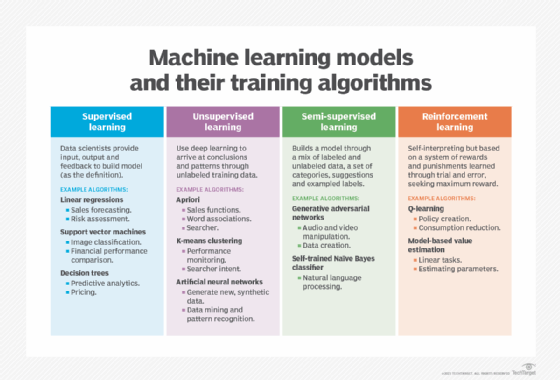
blobbotronic - stock.adobe.com
Learn the business value of AI's various techniques
To drive business value from AI, business managers need to distinguish between the various AI techniques, starting with the many flavors of machine learning.
As artificial technology gains traction in the enterprise, many on the business side remain fuzzy on AI techniques and how they can be applied to drive business value. Machine Learning and deep learning, for example, are two AI techniques that are often conflated. But machine learning can involve a wide variety of techniques for building analytics models or decision engines that don't involve neural networks, the mechanism for deep learning. And there is a whole range of AI techniques outside of machine learning as well that can be applied to solve business problems.
Business managers who recognize these distinctions will have a greater understanding of the business value of AI and be better prepared to have productive conversations with data scientists, data engineers, end users and executives about what's feasible and what's required. These distinctions can also guide discussions about the best way to implement AI applications.
Without a solid understanding of the various aspects and aims of AI techniques, businesses run the risk of not using AI to drive business value, experts in the field said.
Sanmay Das and Nicholas Mattei, chair and vice chair respectively of the Association for Computing Machinery's Special Interest Group on Artificial Intelligence think one of the biggest blind spots is failing to see machine learning as one component of AI.
 Sanmay Das
Sanmay Das
"Some can argue with this characterization, but we think that it loses sight of so much more that is encompassed in the goal of AI, which is to build intelligent agents," Das and Mattei told TechTarget.
Focusing only on the learning aspect of machine learning loses sight of how learning fits into a larger AI loop of perception, reasoning, planning and action. This larger framework can guide managers in understanding how all these areas can be mixed and combined to create intelligent applications.
 Nicholas Mattei
Nicholas Mattei
Even when people are specifically talking about machine learning, they are typically describing supervised learning problems. Das, an associate professor of computer science and engineering at Washington University in St. Louis, and Mattei, an assistant professor of computer science at Tulane University, argued that this narrow view of machine learning techniques leaves out many advances in unsupervised machine learning and reinforcement learning problems that can drive business value.
Learning the business value of AI techniques
Managers often discover machine learning as a byproduct of the success of deep learning. Juan José López Murphy, an AI and big data tech director lead at Globant, an IT consultancy, said the positive side of this trend is that it opens people up to considering how they might apply machine learning to their business. "The money might not always be where the mouth is, but now there's an ear to that mouth," he said.
The downside is that people conflate neural networks with all of machine learning. As a result, he said he hears managers asking questions like "Which deep learning framework are you using?" which is never the relevant aspect of machine learning for a given application.
This confusion also tends to encourage people to focus on AI's "it" technologies, like computer vision and natural language processing. These kinds of applications, while advanced and exciting, are more complex to develop and may not provide as much immediate business value. In many cases, more classical machine learning approaches to tasks -- such as forecasts, churn prediction, risk scoring and optimization -- are better suited to solving business problems.

Decision trees, recommender systems
It is important for business managers to know which AI and machine learning techniques to deploy for which business problems.
For AI implementations requiring transparency and explainability, companies may want to stay away from deep learning techniques, which can result in so-called black box algorithms that are difficult for humans to understand. In these cases, Globant's Lopez Murphy finds clients turning to decision trees or logistic regression algorithms for explicitly reporting the impact of a variable.
 Juan José López Murphy
Juan José López Murphy
Recommender engines, employed to great effect by online giants Netflix and Amazon, are used not only to sell the next item or recommend a movie, but also for internal applications and reports that people look at in their jobs. These applications and reports can be tackled with neural networks, but there are many more suitable approaches, Lopez Murphy said. Forecast models are used to derive confidence intervals that will enable short-term planning or to detect a sudden change in behavior, like outliers or changes to a trend.
"Many of these techniques [e.g., recommender systems and decision trees] have been available and used before deep learning, but are as relevant today, if not more so than they were before," Lopez Murphy said. These types of applications are also able to take advantage of data that is generally more available, curated and relevant than what is required to build deep learning applications.
 Debu Chatterjee
Debu Chatterjee
Debu Chatterjee, senior director of platform AI engineering at ServiceNow, said the IT services software company regularly uses a variety of machine learning capabilities outside of deep learning to drive business value from AI, including classification, identifying similarity between things, clustering, forecasting and recommendations. For example, in service management, incoming tickets are initially read and routed by humans who decide which team is best suited to work on them. Machine learning models trained from these results can automatically route tickets to the best qualified groups for resolution without human intervention. This type of application uses classic supervised machine learning techniques like logistic regression to generate a working model that provides this decision support for optimized work routing.
ServiceNow also uses machine learning for pattern recognition. During a major event, many people call the service organization, but each IT fulfiller only sees one incident at a time, making it nearly impossible to manually recognize the overall pattern. Chatterjee said clustering techniques using machine learning can recognize the overall patterns to identify a major incident automatically, which can help to reduce the overall time to resolve incidents and events.
Solving business problems with machine learning
According to Sachin Vyas, vice president of data, AI and automation products at LTI, an IT consultancy, some of the most popular machine learning-based prediction and decision-making applications used to solve specific business problems include the following:
- Classification algorithms help scan through data to arrive at classes or categories of outcomes. For example, customer sentiment analysis from various posts, comments and other feedback can be collected, and sentiment can then be classified as positive or negative.
- Clustering algorithms aim to identify clusters of entities having similar traits. This is seen in marketing where a cluster of people identified by the algorithm as having expressed positive sentiments about a product are targeted for "new offers" campaigns.
- With back-dated time series data available, you can analyze various seasonal, temporal and external influences within your data and project future numbers with simple forecasting algorithms: e.g., predicting the effect that a marketing campaign will have on sales.
- If your intent is to arrive at a potential number -- a revenue upswing or the number of products you will be able to sell by market or geography -- then you will need to apply regression algorithms.
AI business value from unsupervised learning techniques
 Muddu Sudhakar
Muddu Sudhakar
A wide variety of machine learning algorithms use unsupervised learning, an approach where the training data has not been labeled beforehand. Muddu Sudhakar, CEO of Aisera, a predictive AI service management provider, said that supervised learning models are highly accurate and trustworthy, but they require extensive datasets for training to achieve that high level of accuracy. Conversely, unsupervised learning models are less accurate and trustworthy, but learning takes place in real time without the need of any training data.
The most popular applications of unsupervised learning techniques cluster data into self-organizing maps. Another family of popular unsupervised techniques helps to discover the relationships among objects extracted from the data. Sudhakar said these techniques are popular for market-basket or associative data analysis personalization (i.e., users who buy X and Y products are more likely to buy Z) and recommendation systems for browsing webpages.








